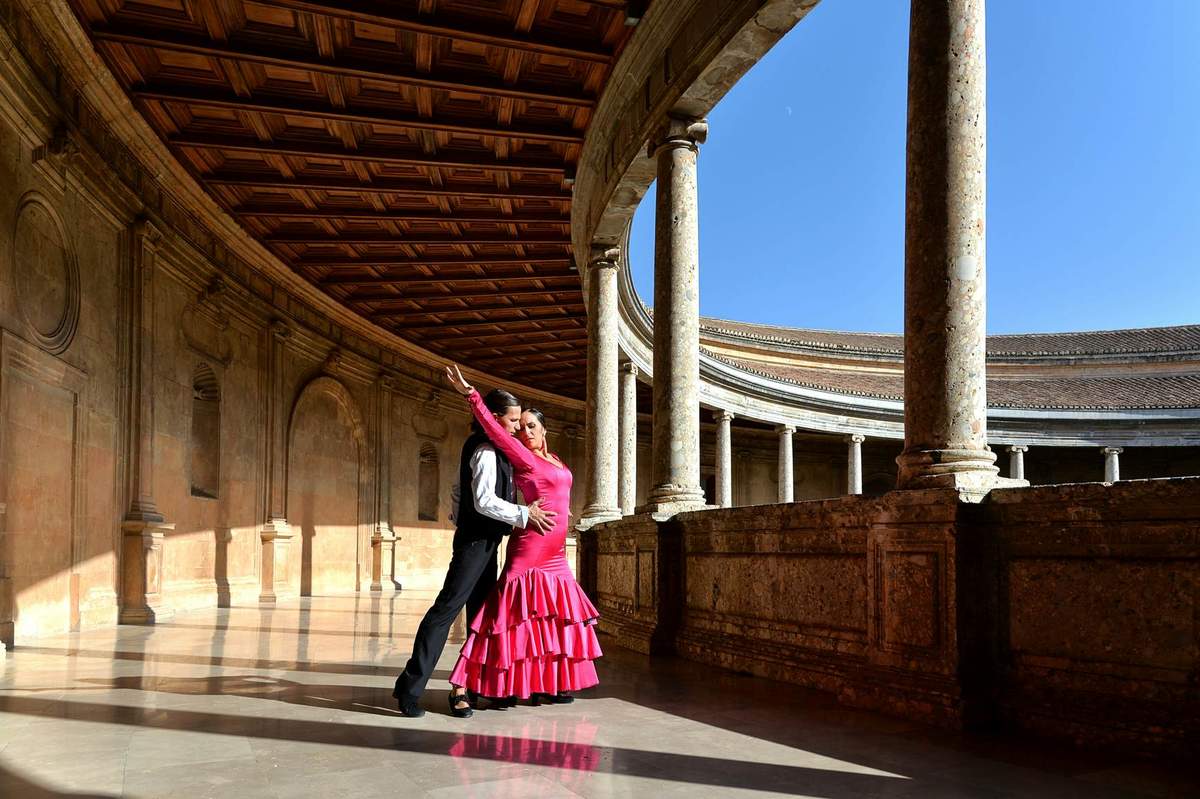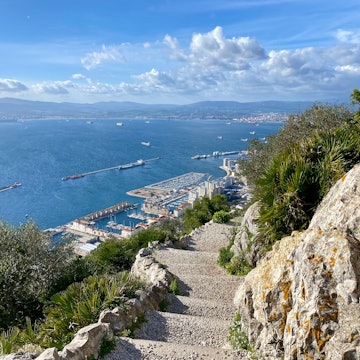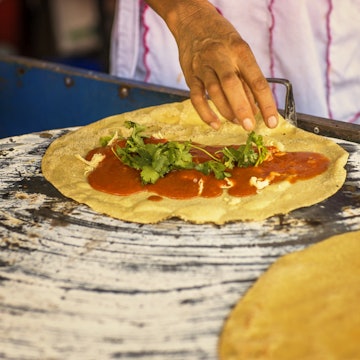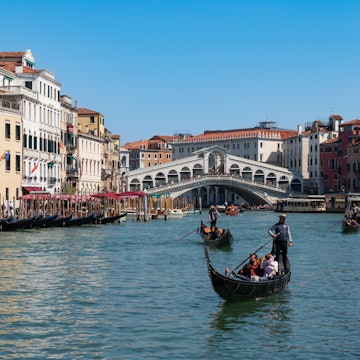

Mercat de la Boqueria is one of Barcelona’s busiest markets and a popular draw for visitors. Only_NewPhoto/Shutterstock
The irresistible sizzle and salty tang of calamari on an open grill. The glint of glossy olives piled high. The sweet drizzle of juice as you bite into gambas slick with aioli. Rainbows of fruit and vegetables, ripe beef tomatoes as big as your fist, strings of chiles and garlic, hanging jamones and an ocean’s worth of seafood so fresh it’s almost still swimming...
Benvinguts (welcome) to Mercat de la Boqueria, a Modernista marvel of a food market in Barcelona’s heart, which takes you gallivanting around Spain on a tapas-sized plate.
In business for more than 800 years, this market is more than just a place to shop: it’s a place to throw yourself wholeheartedly into Barcelona life. Chat with the stallholders, then pull up a stool at a bar for a glass of fizz and a plate of piggy parts. Is it busy? You bet. Touristy? Without doubt. Yet let our guide give you the inside scoop on how best to experience the market regardless.
Bring an appetite.

What is the history of Mercat de la Boqueria?
Looking at the bounty of Mercat de la Boqueria now, it’s hard to picture the humble, spit-and-sawdust meat market that began at the city gates in 1217. Its name is said to derive from the Catalan word boc, meaning billy goat, as this was probably one of the meats most readily available in the Middle Ages.
Designed as Barcelona’s original municipal market, today’s market hall dates back to 1840 and bears the imprint of Catalan architect Josep Mas i Vila. It occupies the site of the former Convent de Sant Josep monastery, which was destroyed by a fire in the early 19th century. The striking stained-glass Modernista gate and metal roof by Antoni de Falguera were added in 1914.
When should I go to Mercat de la Boqueria?
Mercat de la Boqueria is open from 8am to 8:30pm, Monday to Saturday. The fish stalls are closed on Monday. By far the best time to visit the market is between 8am and 10am in the morning, when things are less crowded and chefs peruse the stalls for the freshest ingredients. The pace ramps up by 11am – and by noon you’ll have to elbow your way through the throngs to even get a sniff of the food on offer. Seek out a quieter vibe by avoiding weekends and peak holiday periods.
If you want to eat at one of the stalls, grab a table or stall around noon, before the big lunchtime rush – which brings snaking queues and lengthy waits.
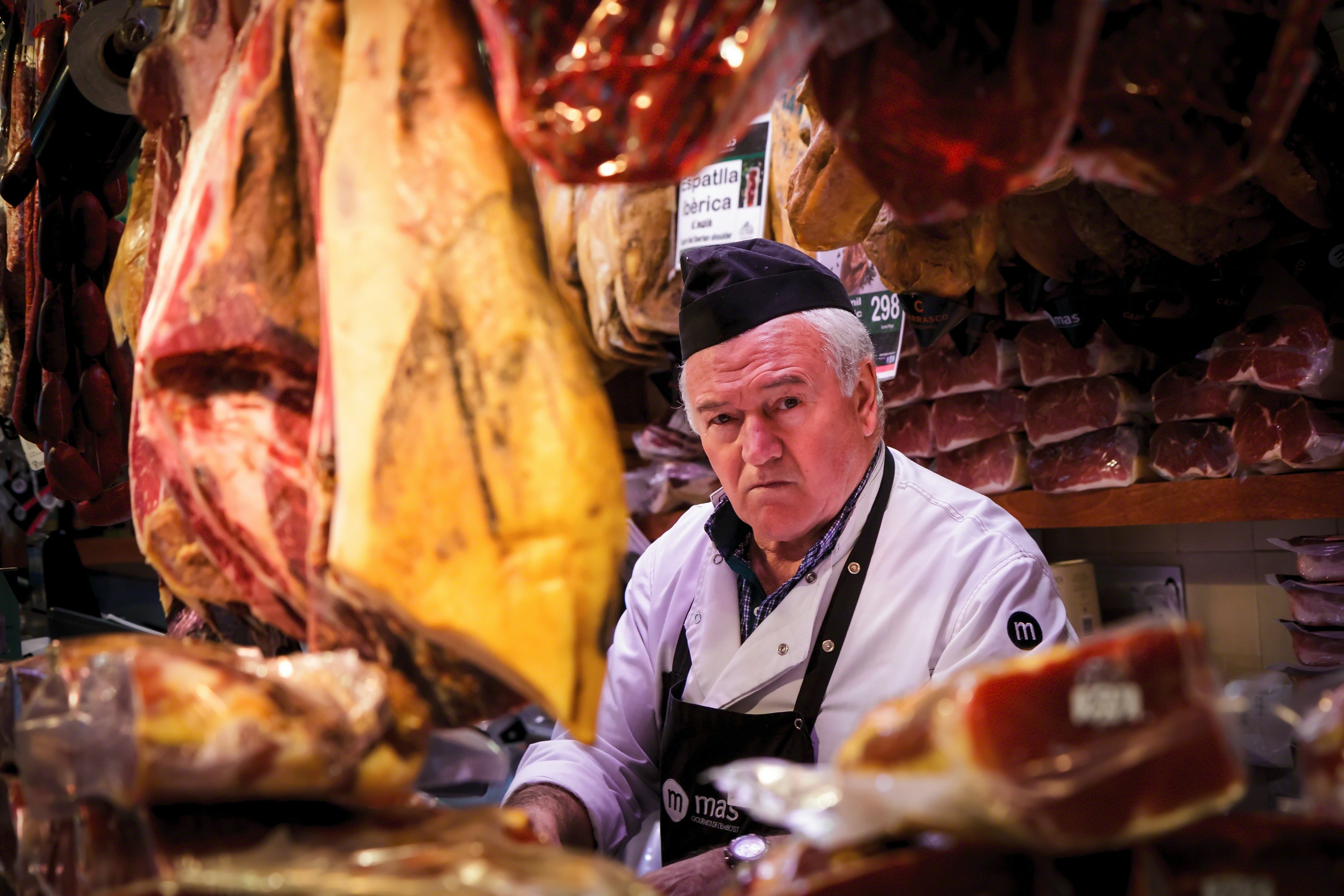
What should I buy at Mercat de la Boqueria?
Before you even get started, take the lead of Barcelonians by skipping past the stalls at the front of the market (near the entrance just off La Rambla) and heading for the back of the market. Here, you’ll find real treasures, better prices and fewer tourists. A friendly “bon dia” (“hello” in Catalan) should kick off your shop on the right foot.
While much of the food is designed to be eaten then and there, you’ll also find rich picnic fixings like tangy chorizos, olives and artisan cheeses from Catalonia or northern Spain’s Picos de Europa mountains. La Ribera’s waterfall-splashed Parc de la Ciutadella, a 20-minutes walk away, is the perfect place to enjoy your to-go feast.
The star of the show is jamon ibérico de Bellota, cured ham from acorn-fed pata negra (black-hoofed) pigs that is sweet, nutty, marbled and melts in the mouth when sliced wafer thin. You’ll pay a small fortune to eat it at the market’s tapas bars, so instead buy some from a butcher like Xarcuteria Barrachina (stand 395). Also look out for fuet (thin, dry-cured Catalonian sausage) and butifarra (fresh pork sausage with sea salt and pepper).
Other great edible gifts to look out for include Catalonian olive oil and retro-wrapped tinned fish from Olives Francesc (stand 949); dried wild mushrooms to pep up any risotto at Bolets Petrà (stand 867); and nutty, honey-laced turrón (nougat) and organic chocolate at Lola Cacau Cafè (stand 190).
What specialities should I try at Mercat de la Boqueria?
Diving deep into the action during lunch is part of the fun. The market is sprinkled with stalls where you can see the chefs shaking the pans, and settle in at the bar over an array of small plates and cava-laced sangria.
Keep an eye open for season-rooted Catalonian specialities like bacallà salat (dried salted cod), often whipped into an esqueixada (a tomato, onion and black-olive salad with frisée lettuce); cargols (snails), baked and served with aioli; peus de porc (fat pig’s trotters); and percebes (goose barnacles), prized off the rocky shores of the coast in Galicia and served with garlic-and-parsley sauce. In winter, you can’t go wrong with a huge plate of calçots, giant spring onions chargrilled and dipped in romesco sauce.

Where is the best place to eat at Mercat de la Boqueria?
The queues speak for themselves at legendary El Quim de la Boqueria, in the market’s mazy heart. A favorite of chefs, this fabulous tapas bar gets jam-packed at lunchtime – and it’s worth the wait to dig into creatively prepared signatures like fried eggs with baby squid zhuzhed up with olive oil, garlic, chile and sea salt; escalivada (roasted aubergines and peppers); butifarra sausage with beans and garlic; and richly meaty oxtail risotto. And you won’t find a better tortilla anywhere.
Seafood, you say? Swing by Ramblero de la Boqueria for stunningly fresh seafood from the Mediterranean: calamari, lobster, clams, shellfish platters, prawns grilled to finger-licking perfection with lemon-garlic oil...you name it; it’s all excellent.
Scoring one of the eight seats at Direkte Boqueria, tucked under the arches in a quiet corner of the market, is like winning the lottery. (Don’t leave it to chance; book at least several weeks ahead.) Arnau Muñío walks the culinary high-wire at this Catalan-Japanese fusion restaurant, where market-inspired, season-led tasting menus canter through exquisite flavors like shrimp with smoked green-tea kombucha, and miso scallops with pickled mushrooms and water chestnut.

What is there to see and do near Mercat de la Boqueria?
Mercat de la Boqueria puts you right in Barcelona’s historic heart, making it easy to combine a shop with some sightseeing. Slip away from the peddlers and buskers on stately La Rambla boulevard and you’ll quickly find yourself in the moodily atmospheric cobbled alleys of the Barri Gòtic (Gothic Quarter), where a serendipitous stroll takes you past hidden plazas and churches, tiny bars and cafes.
If you’re out and about nice and early, you can dodge the biggest crowds on palm-studded, fountain-splashed Plaça Reial, a five-minute walk from the market. Stroll under 19th-century neoclassical arcades, glimpse of Gaudí’s striking cast-iron lampposts and sit down for an alfresco coffee. Just across the way, on the other side of La Rambla, there’s more Gaudí magic at Palau Güell, the neo-Gothic mansion where the architect gave free flight to his fantasy in mosaics and swirling, brilliantly colorful chimney pots that look like something a child might dream up.
Or take a 10-minute walk east to La Catedral, a Gothic wonder of filigree stonework, flying buttresses and gargoyles.
How to get to Mercat de la Boqueria
Mercat de la Boqueria is about halfway down Barcelona’s famous tree-lined boulevard La Rambla. The nearest metro station is Liceu (L3, green line), a two-minute walk away. Bus lines 59 and V13 stop close by.
Tips for visiting Mercat de la Boqueria
Most stands take cards these days, but have some spare change handy for smaller purchases.
If your heart is set on finding something specific, check out the handy map of all 330 stalls on the website to optimize your shopping route.
Bring your own tote bag to carry your purchases.
It’s polite to ask stallholders if you can take photos before snapping away.
Toilets at basement level (-1) are free to use if you present a receipt for a market purchase. Otherwise they cost €0.50 (US$0.52).
Since pickpockets love markets, stash your cash and keep your valuables safe.
Inspired by all the lovely produce? Check out the hands-on cooking classes run by bcnKITCHEN.
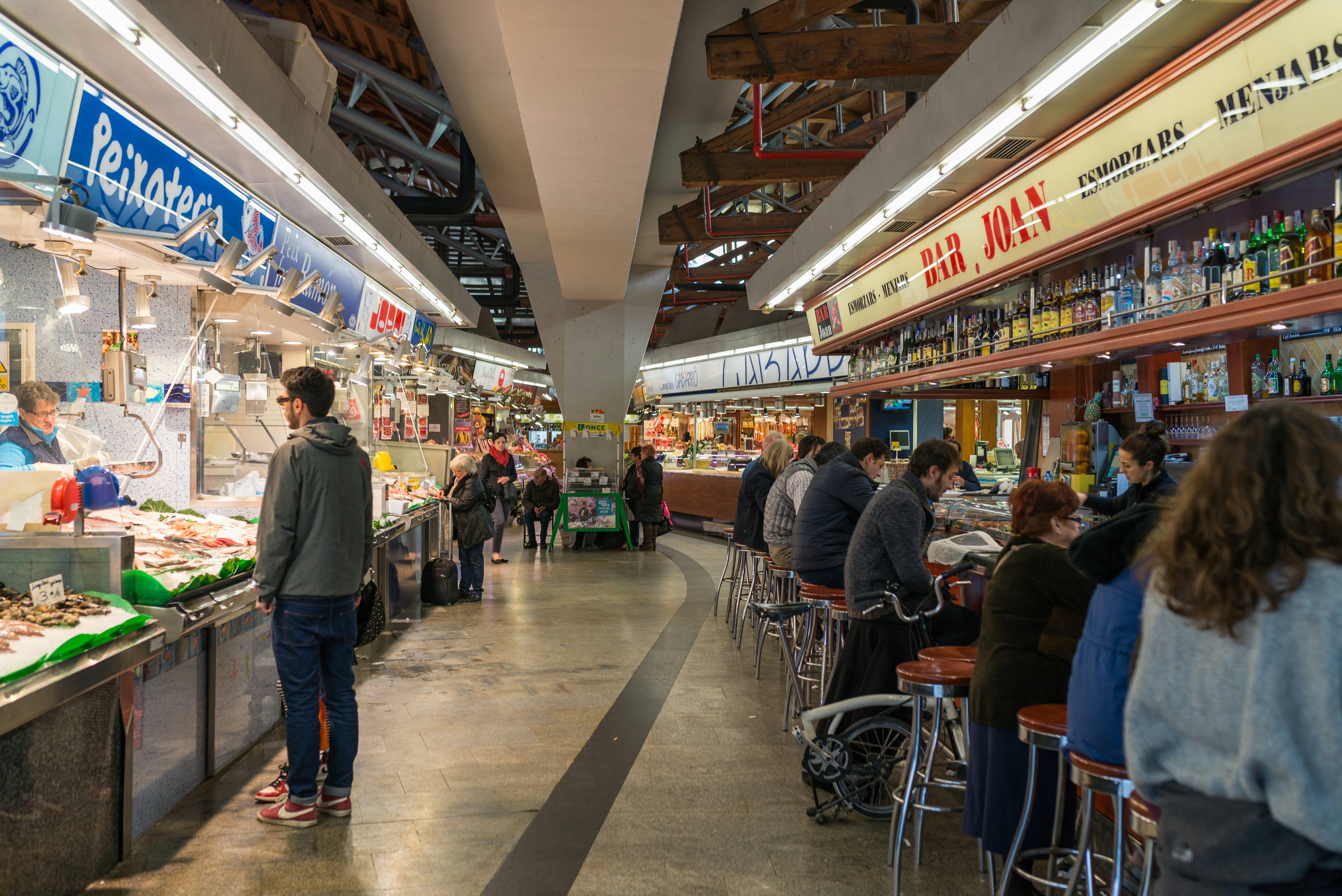
Are there alternative food markets to Mercat de la Boqueria?
For a calmer, more neighborly feel, you might prefer to dip into other Barcelona markets that lie away from the tourist track.
Our pick of the bunch is Mercat de Santa Caterina in La Ribera, where tree-like columns hold up an undulating, kaleidoscopic ceramic roof. Come for a feast of fresh produce, or tapas, paella and a glass of cava at Bar Joan. Another great pick is Mercat de Sant Antoni, on the western fringes of El Raval, where you’ll find plenty to snack on, including cod fritters at Masclans. Swirling with wrought iron, the Modernista Mercat de la Llibertat in Gràcia is full of banter as well as gorgeous fresh produce. Head over to Hermós Bar de Peix for seafood tapas.






